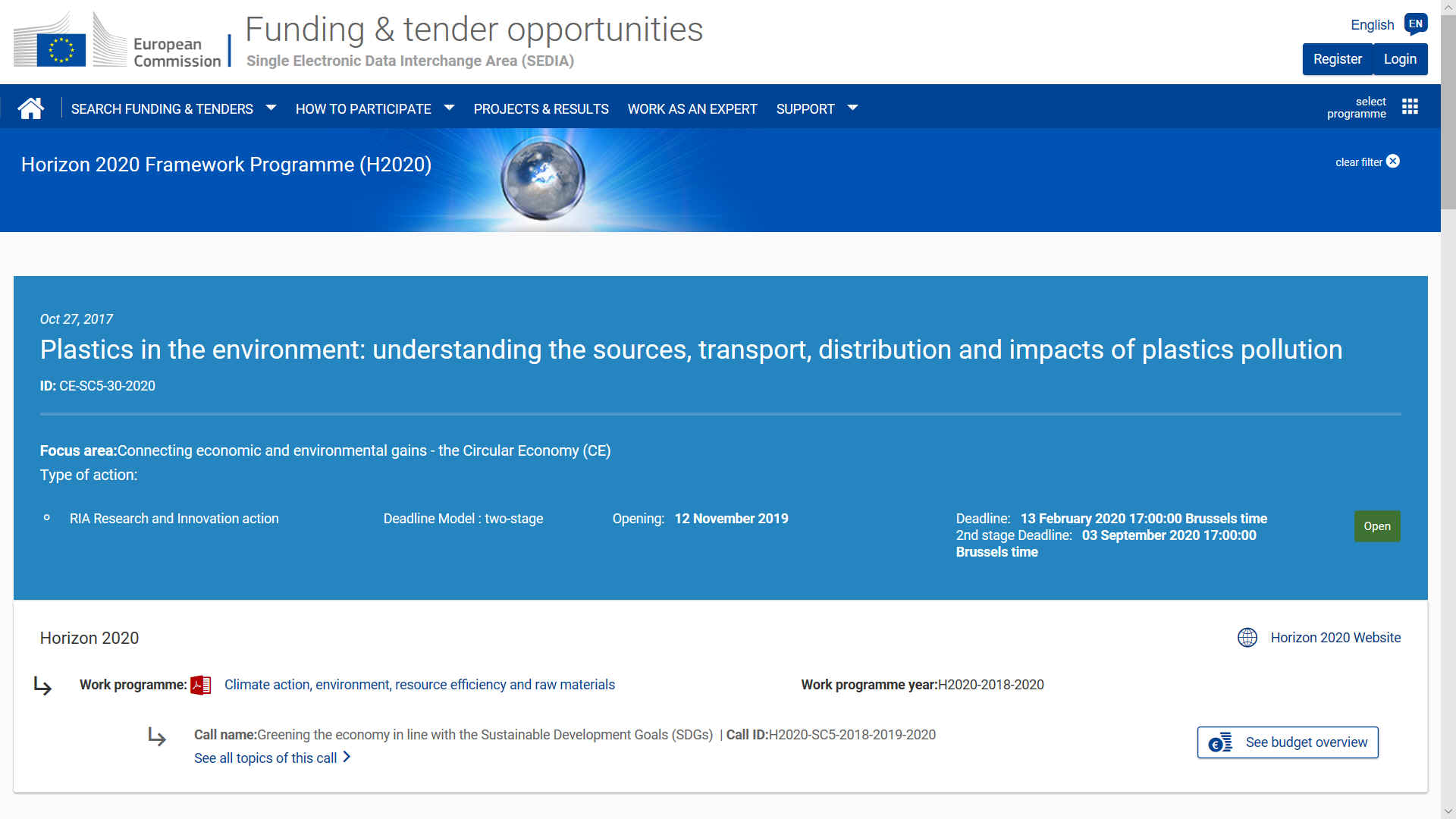|
Call name: Greening the economy in line with the Sustainable Development Goals (SDGs)
Call ID: H2020-SC5-2018-2019-2020
2 stage RIA - 13 February - 03 September
2020
Specific Challenge:
To date, efforts to understand the sources, transport and distribution of plastic pollution have mainly focused on the marine environmental compartment. However, it is widely acknowledged that the majority of marine plastic litter originates from land-based sources and that plastic litter of all sizes is prevalent in all environmental compartments (freshwater, marine, terrestrial, biological and atmospheric).
To develop long-term mitigation solutions, a thorough understanding of the main sources and transport mechanisms of plastics into and through the environment is needed. This needs to be combined with determination of the quantity and composition, an understanding of plastic degradation processes in different environmental compartments and an assessment of plastics impacts on key species and ecosystems. In order to better support the identification of exposed ecosystems and to help decision-makers in reducing exposures, a wider effort bringing together experiences from different disciplines, such as hydrology, oceanography, limnology, monitoring, modelling, chemistry, toxicology, and risk assessments, and from relevant stakeholders, is needed.
Scope:
The aim of this action is to gain a better understanding on the sources, transport, distribution and impact of plastic pollution. The main areas for research activities should include:
a) Sources of plastic pollution to different environmental compartments;
b) Transport and pathways of plastics into and through different environmental compartments;
c) Occurrence and distribution of plastic across all environmental compartments;
d) Accumulation, including in soil and the food chain;
e) Degradation mechanisms for different plastic materials under range of environmentally conditions;
f) Physical and chemical effects of plastic pollution on different biotic and abiotic environments.
This action should aim to determine of the main entry routes of plastics into the different environmental compartments (e.g. marine, surface and groundwaters, soils and air, as well as potential transfers between these compartments. Furthermore, it should investigate the fate and transport behaviour of plastics with the goal of improving our current understanding of exposure within biotic and abiotic compartments. This should include determination of the spatial distribution and variability of plastics from its sources into rivers, lakes, estuaries and coastal areas and the open oceans. The research should contribute to the identification of the entry pathways, transport and accumulation within the ecosystems, including the potential for actual accumulations in the food chain (beyond presence in digestive systems).
Proposals should address different ecosystems, geographical areas and spatial scales, including the main environmental media such as marine, surface and ground-water, soils, air and biota. This would require case studies in selected areas, across Europe considering the marine water column and the seabed as well as surface water and terrestrial ecosystems, and comparative data on the contribution of point and diffuse sources and transport pathways to the scale of plastic pollution.
To enhance understanding of the processes that drive the transport and fate of plastics in different ecosystems and on different temporal-spatial scales, computational models validated with empirical data, that predict hotspots and sinks of plastics would be also needed. Proposals should also enhance the current understanding of plastic degradation in the environment, including the characterisation of leaching chemicals and plastic degradation products. When the degradation of plastics under environmental conditions cannot readily be predicted based on information available from material sciences, degradation experiments simulating realistic weathering of plastics will inform about the fragmenting process of plastic debris as well as the release of chemicals. Research could cover nano-, micro-, or macro-plastics.
Cooperation with existing national and EU funded activities, such as the JPI Oceans initiative, is encouraged.
This topic is in support of the European Strategy for Plastics in a Circular Economy. Selected projects under this topic as well as projects selected under other topics in H2020 supporting the Plastics Strategy are strongly encouraged to participate in joint activities as appropriate. These joint activities could take the form of clustering of projects, participation in workshops, common exploitation and dissemination etc. The proposals are expected to demonstrate support to common coordination and dissemination activities. Applicants should plan the necessary budget to cover those activities without the prerequisite to define concrete common actions at this stage
The Commission considers that proposals requesting a contribution from the EU in the range of EUR 5 million would allow this specific challenge to be addressed appropriately. Nonetheless, this does not preclude submission and selection of proposals requesting other amounts.
Expected Impact:
The project results are expected to contribute to:
achieving the objectives of the Plastics Strategy, in particular with regard to the possibilities for future prioritisation of measures in Europe (prioritisation);
providing a foundation for the development of mitigation solutions, based on improved and new knowledge on plastics pollution;
identifying promising intervention points and targeted actions for fighting plastics pollution, in line with of the CE Action Plan and Plastics Strategy;
establishing the EU as a scientific leader in the area of understanding and solving plastic pollution.
Cross-cutting Priorities: Blue Growth
"Marine Litter has been detected worldwide in all major marine habitats, in sizes from microns to meters. Especially in the marine and coastal environment of semi-enclosed seas, such as the
Mediterranean and
Baltic
Sea, litter pollution is a challenging restoration and governance issue."
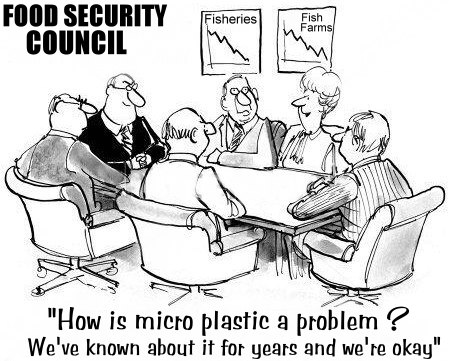
TOPIC CONDITIONS & DOCUMENTS
1. Eligible countries: described in Annex A of the Work Programme.
A number of non-EU/non-Associated Countries that are not automatically eligible for funding have made specific provisions for making funding available for their participants in Horizon 2020 projects. See the information in the Online Manual.
2. Eligibility and admissibility conditions: described in Annex B and Annex C of the Work Programme.
Proposal page limits and layout: please refer to Part B of the proposal template in the submission system below.
3. Evaluation:
Evaluation criteria, scoring and thresholds are described in Annex H of the Work Programme.
Submission and evaluation processes are described in the Online Manual.
4. Indicative time for evaluation and grant agreements:
Information on the outcome of evaluation (single-stage call): maximum 5 months from the deadline for submission.
Signature of grant agreements: maximum 8 months from the deadline for submission.
Information on the outcome of evaluation (two-stage call):
For stage 1: maximum 3 months from the deadline for submission.
For stage 2: maximum 5 months from the deadline for submission.
Signature of grant agreements: maximum 8 months from the deadline for submission.
5. Proposal templates, evaluation forms and model grant agreements (MGA):
Research and Innovation Action:
Specific provisions and funding rates
Standard proposal template
Standard evaluation form
General MGA - Multi-Beneficiary
Annotated Grant Agreement
6. Additional provisions:
Horizon 2020 budget flexibility
Classified information
Technology readiness levels (TRL) – where a topic description refers to TRL, these definitions apply
Members of consortium are required to conclude a consortium agreement, in principle prior to the signature of the grant agreement.
7. Open access must be granted to all scientific publications resulting from Horizon 2020 actions.
Where relevant, proposals should also provide information on how the participants will manage the research data generated and/or collected during the project, such as details on what types of data the project will generate, whether and how this data will be exploited or made accessible for verification and re-use, and how it will be curated and preserved.
Open access to research data
The Open Research Data Pilot has been extended to cover all Horizon 2020 topics for which the submission is opened on 26 July 2016 or later. Projects funded under this topic will therefore by default provide open access to the research data they generate, except if they decide to opt-out under the conditions described in Annex L of the Work Programme. Projects can opt-out at any stage, that is both before and after the grant signature.
Note that the evaluation phase proposals will not be evaluated more favourably because they plan to open or share their data, and will not be penalised for opting out.
Open research data sharing applies to the data needed to validate the results presented in scientific publications. Additionally, projects can choose to make other data available open access and need to describe their approach in a Data Management Plan.
Projects need to create a Data Management Plan (DMP), except if they opt-out of making their research data open access. A first version of the DMP must be provided as an early deliverable within six months of the project and should be updated during the project as appropriate. The Commission already provides guidance documents, including a template for DMPs. See the Online Manual.
Eligibility of costs: costs related to data management and data sharing are eligible for reimbursement during the project duration.
The legal requirements for projects participating in this pilot are in the article 29.3 of the Model Grant Agreement.
8. Additional documents:
1. Introduction WP 2018-20
12. Climate action, environment, resource efficiency and raw materials WP 2018-20
18. Dissemination, Exploitation and Evaluation WP 2018-20
General annexes to the Work Programme 2018-2020
Legal basis: Horizon 2020 Regulation of Establishment
Legal basis: Horizon 2020 Rules for Participation
Legal basis: Horizon 2020 Specific Programme



GET SUPPORT
H2020
online manual
Funding
and tenders Portal FAQ –
Submission of proposals.
National
Contact Points (NCP) - contact your
NCP for further assistance in your national language(s).
Research Enquiry Service – ask questions
about any aspect of European research in general and the EU Research Framework Programmes in particular.
Enterprise Europe Network
– contact your EEN national contact for advice to businesses with special focus on SMEs. The
support includes guidance on the EU research funding.
IT
Helpdesk Contact the Participant
Portal IT helpdesk for questions such as forgotten passwords, access rights
and roles, technical aspects of submission of proposals, etc.
Ethics
– for compliance with ethical issues, see the Online
Manual and Science
and Society Portal
research@cencenelec.eu
Ethics
– for compliance with ethical issues, see the Online Manual and Science
and Society Portal
European IPR Helpdesk assists you on intellectual property issues
CEN and
CENELEC, the European Standards Organisations, advise you how to tackle
standardisation in your project proposal. Contact CEN-CENELEC Research
Helpdesk at: research@cencenelec.eu
The
European Charter for Researchers and the Code of Conduct for their recruitment
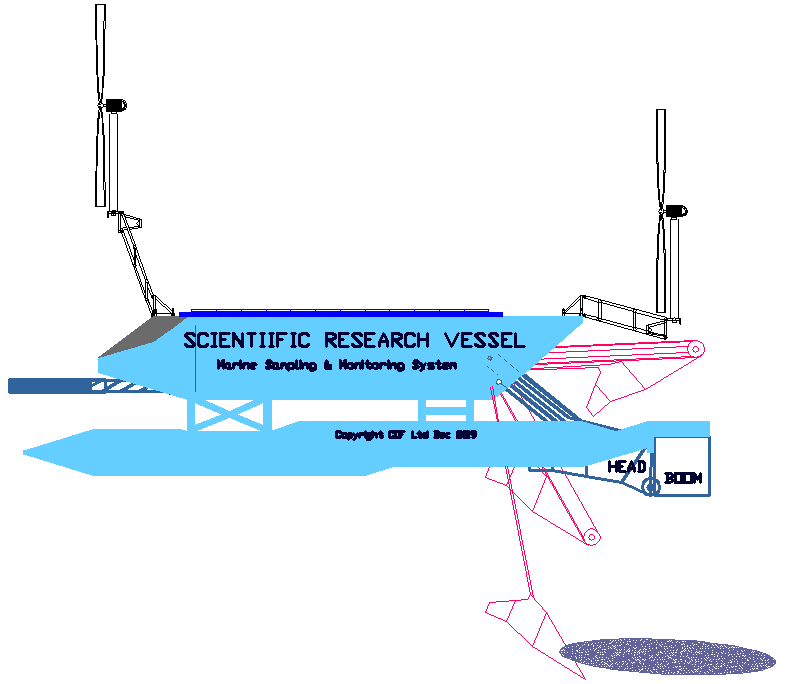
PERSISTENT
MONITORING
- Machines like the Pilot SeaVax
could provide sufficient energy to sample the marine environment continuously,
also able to transport the sensors and sampling equipment anywhere in the
world without using fossil fuels. The head of this machine can be raised out
of the water during transit, and lowered to 8 meters to sample microplastics
near or on the seafloor or riverbeds - example positions shown in red. It
should be possible to design a head to travel to
greater depths, but this will require additional R&D over and above that
to achieve what is shown in principle. Although
we have shown this equipment as part of the SeaVax
Pilot concept, once completed,
heads like this could be fitted to other suitably equipped research vessels
with sufficient energy to be able to operate the equipment.
NOTE:
At the moment this is just a concept, without appropriate levels of funding
for research and then for development, ZEV
research vessels like this will never become a reality. It would be a
mistake to think that with a drawing like that above, that the research to
make it possible has already been done.
CALL INFORMATION
This call focuses on moving to a greener, more resource efficient and climate-resilient economy in sync with the natural environment, demonstrating a strong commitment to supporting the
UN's Sustainable Development Goals (SDGs).
Connecting economic and environmental gains - the circular economy (topics: CE-SC5-01-2018, CE-SC5-02-2018, CE-SC5-03-2018, CE-SC5-04-2019 and CE-SC5-05-2018)
Further development of a sustainable, resource efficient and competitive economy will require a transition to a more circular economic model with products, processes, services and business models that are designed to maintain the value and utility of materials and resources in the economy for as long as possible. The circular economy solutions should combine a strong environmental rationale with a convincing business logic.
Actions in this part of the call aim in the medium term to substantially improve the efficiency of resource use (including energy and water), to minimise the production of waste and increase the use of resources originating from secondary sources – while avoiding adverse health effects – and to reduce pollution and greenhouse gas emissions. They intend to elucidate the role of design in product durability, enhance the capacity of cities to embrace circular economy approaches and support the transition to systemic, integrated solutions closing the cycles of resource use in the water sector.
They will contribute to implementing the Circular Economy Action Plan[[COM(2015) 614 final]] and key high-level EU priorities, including those addressing jobs, growth and investment, climate and energy, and a strengthened industrial base. Ultimately, they are expected to support Europe's endeavours to implement the Sustainable Development Goals (SDGs), particularly SDG 12 'Responsible consumption and production', SDG 6 'Ensure availability and sustainable management of
water and sanitation for all', SDG 11 'Sustainable cities and communities' and SDG 13 'Take urgent action to combat
climate change and its impacts' (and the goals of the
Paris Agreement on climate change), together with the Habitat III New Urban Agenda.
The topics in this part of the call contribute to the focus area 'Connecting economic and environmental gains - the circular economy'.
It should be noted that a number of topics (with "CE-" in the topic identifier) in the 'Raw Materials' section of this call also contribute to the circular economy.
Raw materials (topics: CE-SC5-06-2018, CE-SC5-07-2018-2019-2020,
CE-SC5-08-2018-2019-2020, SC5-09-2018-2019 and SC5-10-2019-2020)
The EU is highly dependent on raw materials that are crucial for a strong European industrial base, an essential building block of the EU's growth and competitiveness. The main aim of this part of the call will be on achieving the objectives and meeting the targets of the EIP on Raw Materials. A wide range of actions will cover the entire EU raw materials value chain, from sustainable exploration, extraction, processing to recycling. Actors from the whole EU raw materials innovation chain will be involved, including researchers, industry, end-users, public authorities and civil society.
In the short to medium term, innovation actions are expected to deliver pilot actions demonstrating sustainable production of primary and secondary raw materials, particularly CRM or other scarce high-tech metals. Breakthrough research concepts, as the basis of tomorrow's innovations, are also tackled through smaller, lower-TRL actions. Actions will also contribute to building the EU knowledge base of primary and secondary raw materials for solid decision making, and particularly to the further development of the EC Raw Materials Information System – RMIS
https://ec.europa.eu/jrc/en/scientific-tool/raw-materials-information-system
responding to the Circular Economy Action Plan and the objectives of the Strategic Implementation Plan of the EIP on Raw Materials. Policy-related actions aim at improving framework conditions for the sustainable development of and investment in innovative solutions in the EU. In the long term, actions should positively impact on: downstream industries' access to raw materials; employment in and competitiveness of the EU raw materials and related manufacturing industries, including SMEs; the environmental and social performance of the raw materials sector; and improved public awareness, acceptance and trust. International co-operation is encouraged in all actions. Ultimately, the actions on raw materials are expected to support Europe's endeavours to implement the Sustainable Development Goals (SDGs), notably SDG 12 'Responsible Consumption and Production'.
Topics relevant to bio-based materials (e.g. wood) and the bio-economy can be also found in Societal Challenge 2 'Food security, sustainable agriculture and forestry, marine, maritime and inland water research, and the bio-economy' and the Joint Undertaking for Bio-Based Industries (BBI). Innovation actions with relevance to raw materials can be found in the calls under the SPIRE PPP.
Topics in this part of the call that contribute to the focus area 'Connecting economic and environmental gains - the circular economy' (prefix 'CE') will contribute to the implementation of the EU Circular Economy Action Plan.
Water for our environment, economy and society (topics: SC5-11-2018 and SC5-12-2018)
Changes in water availability, the frequency of floods and droughts due to climate and other environmental changes, pollution trends, increased competition in water use including for industry, energy, agriculture and food production, land-use changes and increasing urbanisation all require the development and implementation of robust, smart, effective and tailored water management systems, solutions and multi-sectoral governance models in Europe and globally. The transformative potential of digital technologies can play an important role in doing so.
This part of the call supports and aims to accelerate the implementation of EU policies
http://ec.europa.eu/environment/water/index_en.htm
and initiatives
e.g. EIP Water,
http://ec.europa.eu/environment/water/innovationpartnership/
relating to water, resource efficiency and water-dependent industries, while also contributing to policy relating to the Energy Union, climate action and the digital economy. Overall, actions are expected to lead in the medium term to: digital solutions for improved public- and private-sector decision-making on water-related risks, efficiency and resilience; substantial reductions in water and energy consumption; and the development of new markets for water-smart technologies and services. A further action focuses on EU-India cooperation to improve wastewater efficiency and quality of and access to drinking water in India. Ultimately, actions are expected to support Europe's endeavours to implement the Sustainable Development Goals (SDGs), particularly SDG 6 'Clean water and sanitation' and SDG 13 'Climate action'.
It should be noted that topic CE-SC5-04-2019 'Building a water-smart economy and society' in this call, as well as topics in the call 'Building a low-carbon, climate resilient future: climate action in support of the Paris Agreement' also contribute to this priority. Relevant actions are also called for under the SPIRE cPPP in the LEIT-NMBP part of this Work Programme.
Innovating cities for sustainability and resilience (topics: SC5-13-2018-2019 and SC5-14-2019)
Most of the challenges Europe is facing today, such as climate change, water and waste management, health, social cohesion and immigration, have a strong urban dimension. However cities are also hubs of technological and social innovation, the places where capital investments, high productivity and high-skilled jobs are located. In this sense, cities not only contribute and are exposed to global challenges but they are also key players in providing solutions.
Actions in this part of the call have the medium-term objective of enabling cities to design and implement transition pathways to becoming inclusive, resilient, sustainable, low-carbon and resource efficient by enhancing their innovation capacity and enabling them to act as hubs of innovation. Further actions aim to strengthen the sustainability of urban areas globally, and particularly in
China and CELAC countries. Ultimately, they are expected to support Europe's endeavours to implement the Sustainable Development Goals (SDGs), particularly SDG 11 'Sustainable cities and communities' and
SDG 3 'Ensure healthy lives and promote well-being for all at all ages', together with the Habitat III New Urban Agenda, and the EU Urban Agenda
https://ec.europa.eu/futurium/en/urban-agenda
It should be noted that topic CE-SC5-03-2018 'Demonstrating systemic urban development for circular and regenerative cities' in this call also contributes to this priority.
EARTH OBSERVATION
Protecting and leveraging the value of our natural and cultural assets: Earth observation (topics: SC5-15-2018 and SC5-16-2019)
The Commission, together with the European GEO nations, is committed to implementing GEOSS in line with the new GEO Strategic Plan 2016-2025 and to developing an approach towards GEOSS for the European region (supporting the EuroGEOSS initiative of the European GEO
caucus
For information on the European GEO caucus, please see the GEO High-Level Working Group at:
http://ec.europa.eu/transparency/regexpert/index.cfm?
That facilitates and steers national contributions while accelerating the use of GEOSS resources. At the same time, the capacity to observe the planet is evolving rapidly, leading to higher volumes of and more diverse data flows produced at European and national level by private and public operators (including from citizens).
Actions in this part of the call aim to capitalise on these trends, in collaboration with the Copernicus programme, to develop new mass-market applications for businesses, citizens and public authorities. Overall, actions are expected in the medium term to stimulate growth and jobs in Europe in the context of the digital economy (through open innovation) and to lead to better informed decision-making in environmental policy and management and in disaster management. Actions will also contribute to implementing EU space policy and to international agreements such as the 2030 Agenda for Sustainable Development, particularly Sustainable Development Goals (SDGs) 9 'Industry, innovation and infrastructure, 11 'Sustainable cities and communities', 13 'Climate action, 14 'Life below water' and 15 'Life on land'.
It should be noted that topics addressing Earth observation can also be found in other parts of the Horizon 2020 Work Programme 2018-2020, notably:
in a dedicated part of the call 'Space 2018-2020' (H2020-SPACE-2018-2020) in the Work Programme part 'Leadership in Enabling and Industrial Technologies - Space'
certain topics in the call 'Blue Growth' (H2020-BG-2018-2020) in the Work Programme part 'Food security, sustainable agriculture and forestry, marine, maritime and inland water research and the bioeconomy'
the EIC Prize 'Early Warning for Epidemics' in the Work Programme part 'Towards the next EU Framework Programme for Research and Innovation: European Innovation Council (EIC) Pilot'.
Protecting and leveraging the value of our natural and cultural assets: Nature-based solutions, disaster risk reduction and natural capital accounting (topics: SC5-17-2018, SC5-18-2018
EARTHQUAKES
Predicting earthquakes reliably and enhancing early warning capacity prior to an earthquake would enable the timely rolling out of emergency plans and actions and prevent the loss of human lives. Similarly, mainstreaming the actual value of nature into our economic transactions would fostered a wiser use and management of our natural capital and sustained biodiversity and ecosystems’ productive capacity for our benefit but also for the benefit of the future generations. Actions under this section will help create economic, social and environmental resilience in our societies.
Actions under this section of the call aim to improve decision making, early warning, preparedness and communication among relevant actors to better cope with earthquakes through enhanced forecasting capacity. Furthermore, they aim to enhance the capacity of authorities and the private sector to better assess and value biodiversity, ecosystems and their services to enable them to incorporate and mainstream these values into their accounting and decision making frameworks.
Ultimately, they are expected to support Europe's endeavours to implement the Sustainable Development Goals (SDGs), particularly SDG 3 'Ensure healthy lives and promote well-being for all at all ages',
SDG 6 'Ensure availability and sustainable management of water and sanitation for all',
SDG 8 'Promote sustained, inclusive and sustainable economic growth, full and productive employment and decent work for all', SDG 11 'Make cities and human settlements inclusive, safe, resilient and sustainable',
SDG 13 'Take urgent action to combat climate change and its impacts' and SDG 15 'Protect, restore and promote sustainable use of terrestrial ecosystems, sustainably manage forests, combat desertification, and halt and reverse land degradation and halt biodiversity loss'.
It should be noted that topic LC-CLA-06-2019 ''Inter-relations between climate change,
biodiversity and ecosystem services' in the call 'Building a low-carbon, climate resilient future: climate action in support of the Paris Agreement' also contributes to this priority.
HERITAGE
Protecting and leveraging the value of our natural and cultural assets: Heritage alive (topics: SC5-19-2018 and SC5-20-2019)
Cultural heritage is a non-renewable, irreplaceable resource and a common good, but is frequently under threat from environmental challenges and climate change, disaster risks, neglect, decay and under-funding. It can play a crucial and catalytic role in well-being, cultural diversity, sustainable development and social cohesion and as such it needs to be protected and preserved through leveraging its innovation potential.
Actions in this part of the call have the medium-term objective of positioning cultural heritage at the centre of sustainable development and unlocking its potential as a strategic living resource and driver for economic growth and job creation, social cohesion and environmental sustainability. By doing so, they will also contribute to the protection and preservation of cultural and historic heritage in Europe and beyond and will mobilise investments in the sector leading to the emergence of a global market for heritage-led innovative solutions and services. Ultimately, they are expected to support Europe's endeavours to implement the Sustainable Development Goals (SDGs), particularly
SDG 11 'Sustainable cities and communities' and its target of strengthening efforts to protect and safeguard the world’s cultural and natural heritage.
It should be noted that topic 'LC-CLA-04-2018: Resilience and sustainable reconstruction of historic areas to cope with climate change and hazard events' in the call 'Building a low-carbon, climate resilient future: climate action in support of the Paris Agreement' also contributes to this priority.
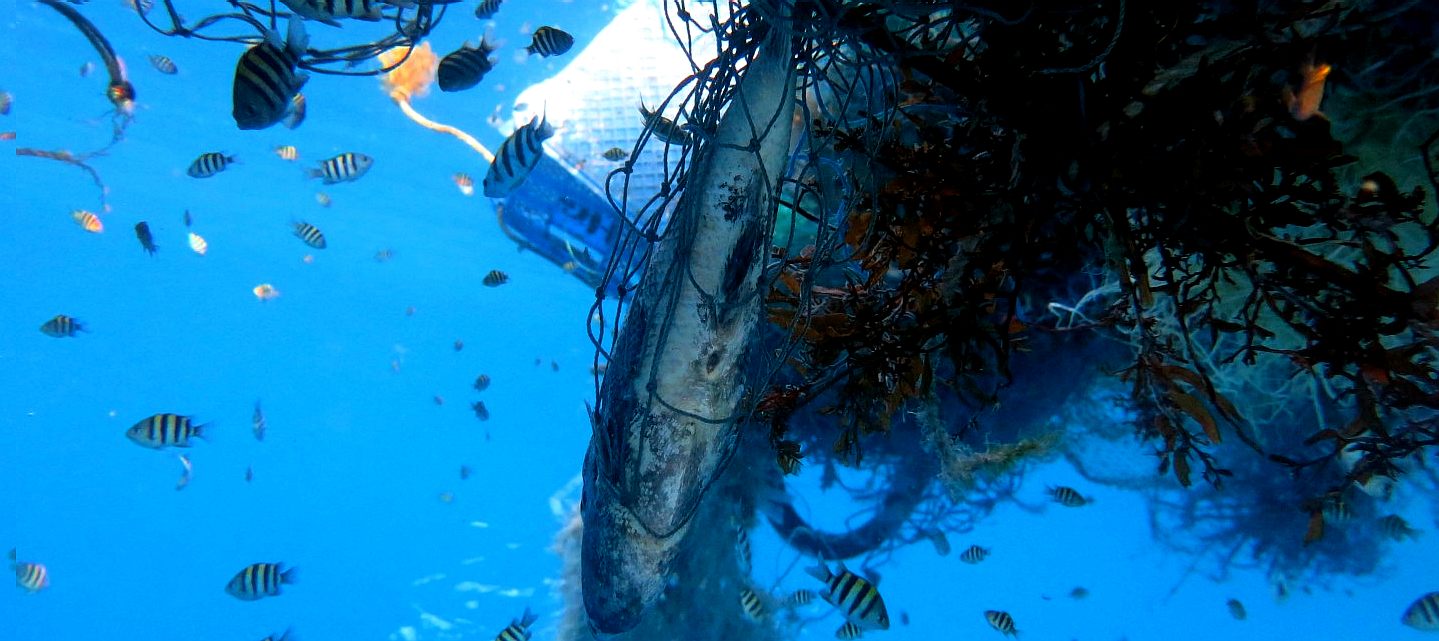
PROBLEM
- From 2000 to 2012, the National
Marine Fisheries Service reported an average of 11 large whales entangled in
ghost nets every year along the US west coast. From 2002 to 2010, 870 nets
were recovered in Washington (state) with over 32,000 marine animals trapped
inside. Ghost gear is estimated to account for 10% of all marine litter.
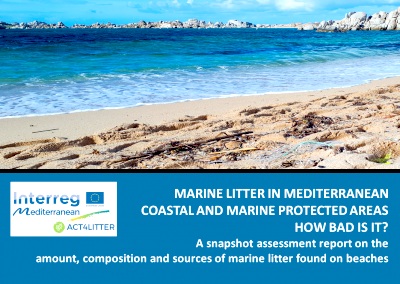
According to the SeaDoc Society, each ghost net kills $20,000 worth of
Dungeness crab over 10 years. The Virginia Institute of Marine Science
calculated that ghost crab pots capture 1.25 million blue crabs each year in
the Chesapeake Bay alone. In May 2016, the Australian Fisheries Management Authority (AFMA) recovered
10 tonnes of abandoned nets within the Australian Exclusive Economic Zone
and Torres Strait protected zone perimeters.
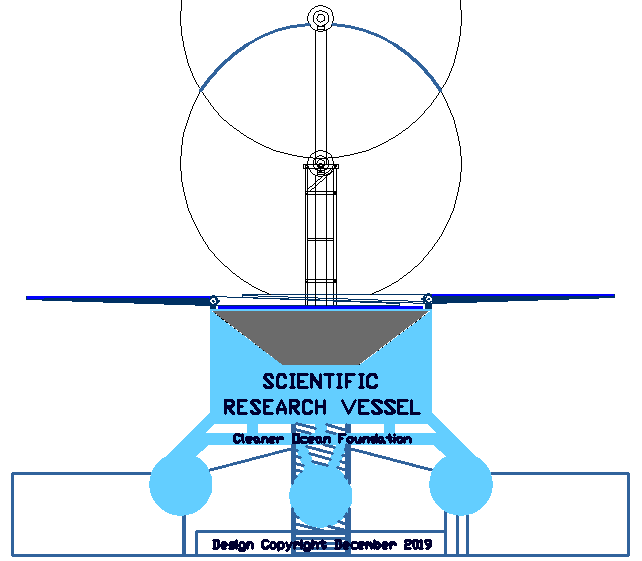
ENERGY
AUTONOMOUS - For long range sampling and routine data
transmissions relating to plastics and other marine pollutants that may be
large or small, quite a lot of energy is required. Renewable wind and solar
energy provides an elegant solution in the quest for a truly circular
economy. This platform is designed to provide 23kW (peak) of electrical
power, some stored in a battery bank, to even out the energy lows. This is
achieved using solar panels and wind turbines in combination with computer
controlled energy harvesting.
This
end elevation shows the surface capture booms extended to 12 meters, lowered
to a depth of 2 meters below the surface of the water to direct floating
waste to the conveyor. The head may be lowered independently of the booms to
8 meters for deeper sampling.
 LINKS
& REFERENCE https://ec.europa.eu/info/funding-tenders/opportunities/portal/screen/opportunities/topic-details/ce-sc5-30-2020
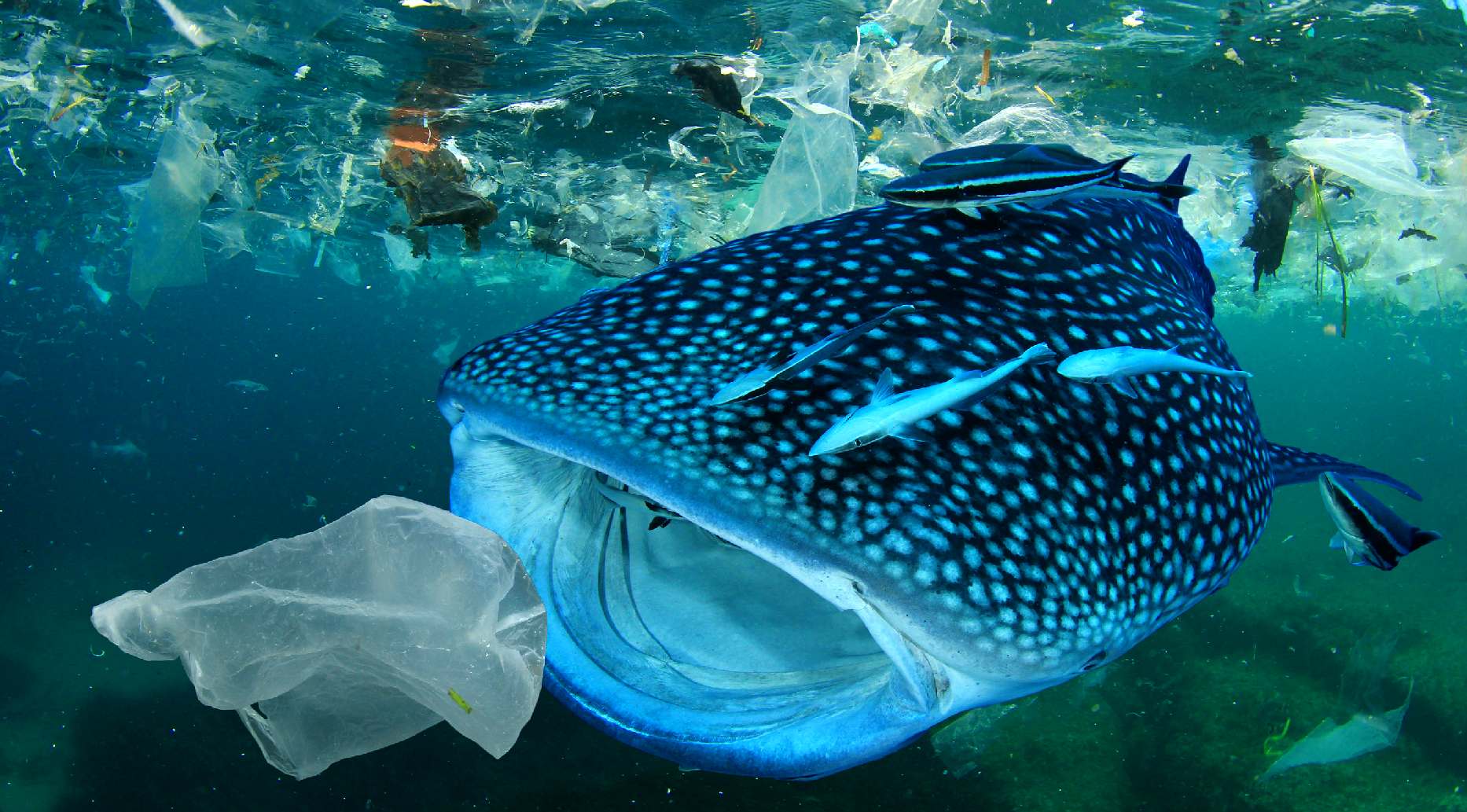
WHAT DRIVES US -
It is pictures like this whale shark
swimming in garbage that it is about to ingest that makes our blood boil. What
are we doing, letting a situation like this develop? The fish eat the
plastic and we eat the toxic fish. We are slowly poisoning ourselves and our
world.
|
